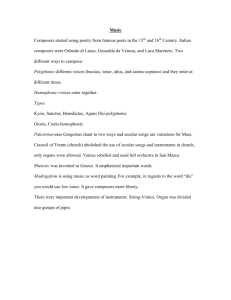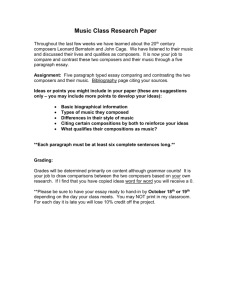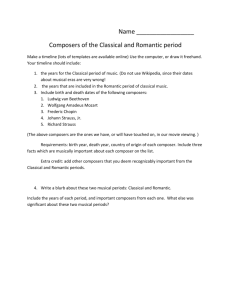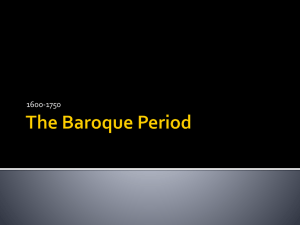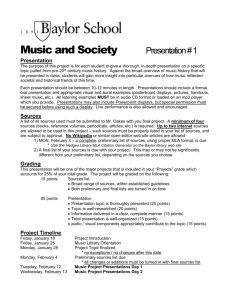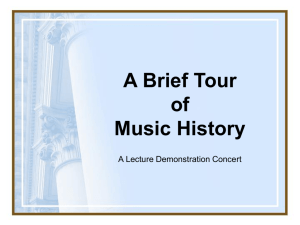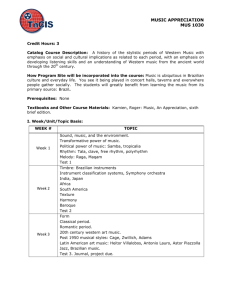Commonwealth of Pennsylvania KUTZTOWN UNIVERSITY Kutztown, Pennsylvania
advertisement
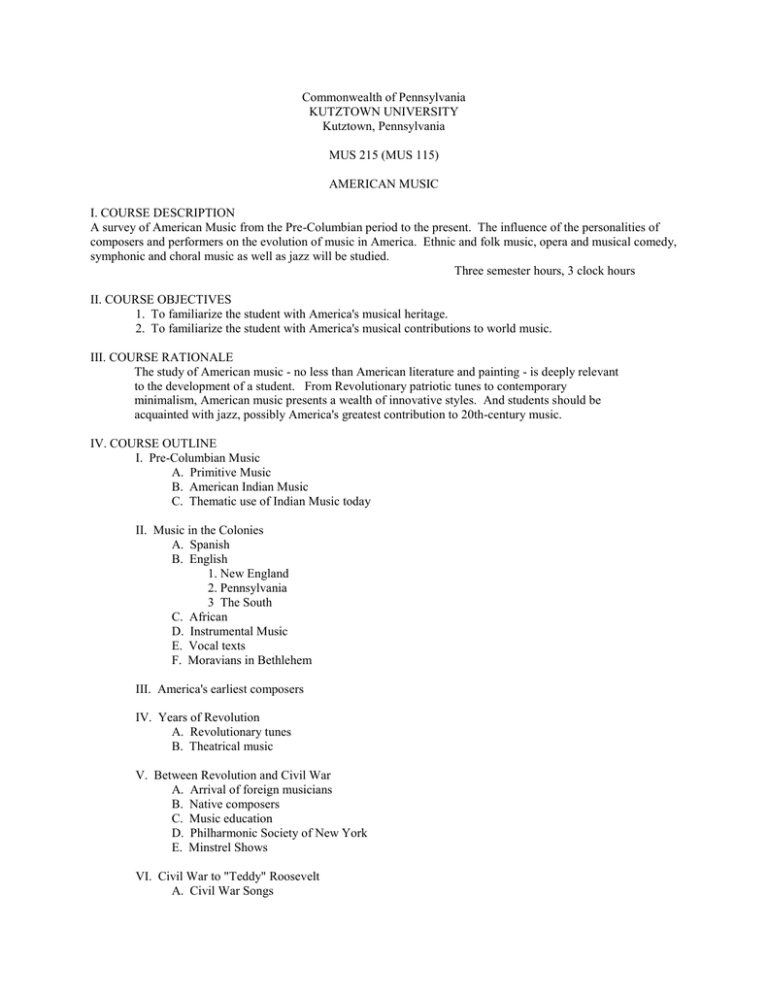
Commonwealth of Pennsylvania KUTZTOWN UNIVERSITY Kutztown, Pennsylvania MUS 215 (MUS 115) AMERICAN MUSIC I. COURSE DESCRIPTION A survey of American Music from the Pre-Columbian period to the present. The influence of the personalities of composers and performers on the evolution of music in America. Ethnic and folk music, opera and musical comedy, symphonic and choral music as well as jazz will be studied. Three semester hours, 3 clock hours II. COURSE OBJECTIVES 1. To familiarize the student with America's musical heritage. 2. To familiarize the student with America's musical contributions to world music. III. COURSE RATIONALE The study of American music - no less than American literature and painting - is deeply relevant to the development of a student. From Revolutionary patriotic tunes to contemporary minimalism, American music presents a wealth of innovative styles. And students should be acquainted with jazz, possibly America's greatest contribution to 20th-century music. IV. COURSE OUTLINE I. Pre-Columbian Music A. Primitive Music B. American Indian Music C. Thematic use of Indian Music today II. Music in the Colonies A. Spanish B. English 1. New England 2. Pennsylvania 3 The South C. African D. Instrumental Music E. Vocal texts F. Moravians in Bethlehem III. America's earliest composers IV. Years of Revolution A. Revolutionary tunes B. Theatrical music V. Between Revolution and Civil War A. Arrival of foreign musicians B. Native composers C. Music education D. Philharmonic Society of New York E. Minstrel Shows VI. Civil War to "Teddy" Roosevelt A. Civil War Songs B. Symphonic maturity C. Composers of the period D. Dvorak and his influence upon American composers VII. The Twentieth Century A. The First Decade 1. Technical advancements 2. Orchestral contributions 3. "Popular" and "Tin Pan Alley" music 4. Composers of the decade B. World War I 1. Jazz 2. Vaudeville and "Pop" music 3. Folk music 4. Classical music C. The Twenties 1. Jazz and Radio 2. Music schools 3. Opera performance 4. Composers 5. The Concert Band D. The Thirties and the "Crash" 1. Federal projects 2. American Opera flowers 3. Growth of the symphony orchestra 4. Composers - Nationalism, Eclecticism and Internationalism E. American Folk Music F. World War II and the times around it 1. Ballet 2. Opera 3. Musical Comedy 4. Jazz and "Pop" Music 5. Composers VIII. Music at the Half-Century to the present A. Music Education B. New "schools" of composition C. Radio and television D. Opera and Broadway Musicals E. America: a world music center F. American Music: future trends V. ASSESSMENT A. Two examinations (mid-term and final) B. A research paper on one aspect of American Music (ex: a composer, style inovation such as metric modulation, or religious sect such as the Shakers) C. individual class presentation: a live performance or demonstration may be used D. Concert attendance and written report VI. INSTRUCTIONAL RESOURCES Boggs, Vernon. Salsiology: Afro-Cuban Music and the Evolution of Salsa in New York City. NY: Greenwood Press, 1992. Campbell, Michael. And the Beat Goes On: An Introduction to Popular Music in NY: Schirmer Books, 1996. America, 1840 to Today. Carney, George O., Ed. The Sounds of People and Places: A Geography of American Folk and Popular Music. Lanham, MD: Rowman and Littlefield, Pub.,1994. Chase, Gilbert. America's Music. NY: McGraw-Hill, 1987. Collier, James L. Jazz: the American Theme Song. NY: Oxford University Press, 1993. Davis, Lee. Bolton and Wodehouse and Kern: The Men Who Made Musical Comedy. Inc., 1993. NY: James H. Heineman, DiGaetani, John L. and Sirefman, Josef P., Eds. Opera and the Golden West: the of Opera in the USA Rutherford: Fairleigh Dickenson University Press, 1994. Past, Present, and Future Ewen, David. Panorama of American Popular Music. Englewood-Cliffs, NJ: Prentice-Hall, 1957. Ferris, Jean. America's Musical Landscape, 3rd edition. NY: Wm. C. Brown Publishers, 1997. Gagne, Cole. Soundpieces 2: Interviews with American Composers. Metuchen, NJ: Scarecrow Press, 1993. Heth, Charlotte, Ed. Native American Dance: Ceremonies and Social Traditions. Starwood Publishers, 1992. Washington, DC: Heyman, Barbara B. Samuel Barber: The Composer and His Music. NY: Oxford University Press, 1992. Hitchcock, H. Wiley, Music in the United States. 4th ed. Prentice Hall, Upper Saddle River, NJ, 2000. Jenkins, Walter S. The Remarkable Mrs. Beach, American Composer. Warren, MI: 1994. Harmonie Park Press, Kaufmann, Helen (Loeb). From Jehovah to Jazz. Freeport NY: Library Press, 1968. Keeling, Richard. Cry for Luck: Sacred Song and Speech Among the Yurok, Hupa, and Karok Indians of Northwestern California. Berkeley: University of California Press, 1992. Kingman, Daniel. America's Music: A Panorama. NY: Schirmer Books, Inc., 1990. Levy, Lester S. Grace Notes in American History. University of Oklahoma Press, 1967. Lewis, George H., Ed. All that Glitters: Country Music in America. Bowling Green, University, 1993. Lott, Eric. Love and Theft: Blackface Minstrelsy and the American Working Class. NY: Oxford University Press, 1993. Marrocco, William Thomas. Music in America. NY: W. W. Norton, 1964. OH: Bowling Green Mellers, Wilfred H., Music in a New Found Land. NY: A. K. Knopf, 1965. Peters, Erskine. Lyrics of the Afro-American Spiritual: a Documentary Collection. Westport, CT: Greenwood Press, 1993. Saminskay, Lazare. Living Music of the Americas. NY: Howell, Soskin, 1949. Starr, S. Frederick. Bamboulai: The Life and Times of Louis Moreau Gottschalk. NY: Oxford University Press, 1995. Strickland, Edward. American Composers: Dialogues on Contemporary Music. Bloomington, IN: Indiana University Press, 1991. Tawa, Nicholas E. American Composers and Their Public. Metuchen, NJ: Scarecrow Press, 1995. _______. Mainstream Music of Early Twentieth Century America: The Composers, Works. Westport, CT: Greenwood Press, 1992. Update 11/03 Their Times, and Their

